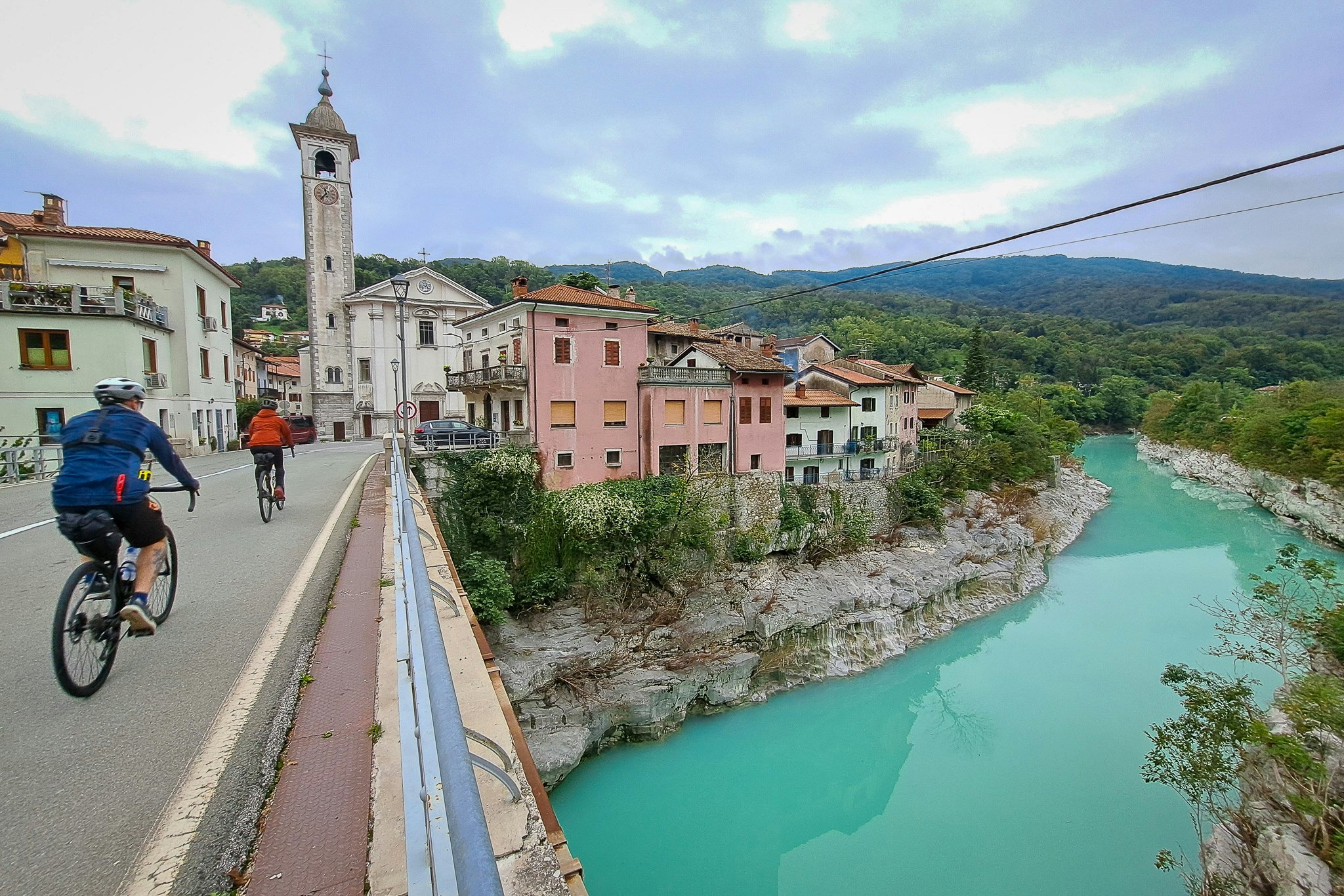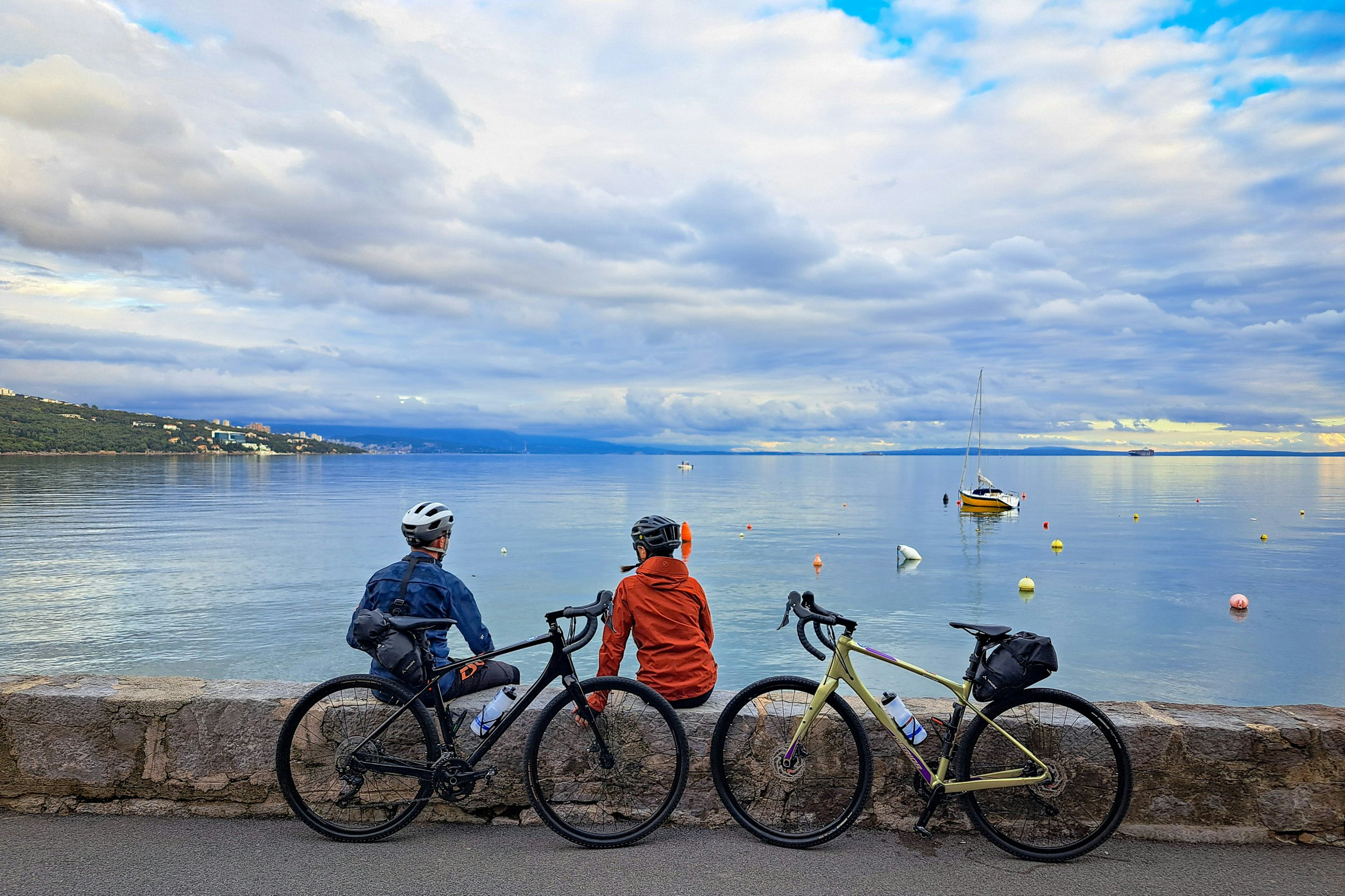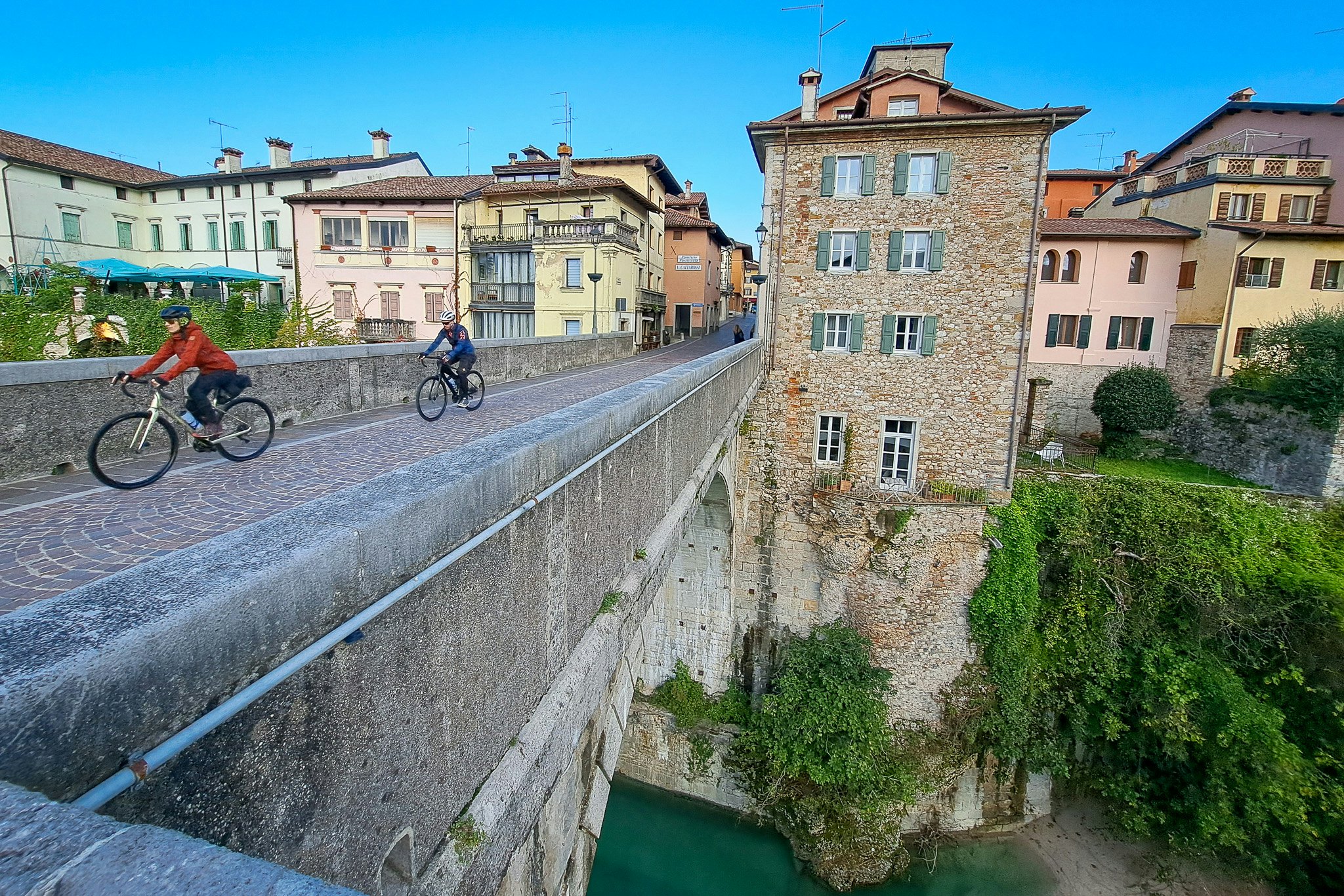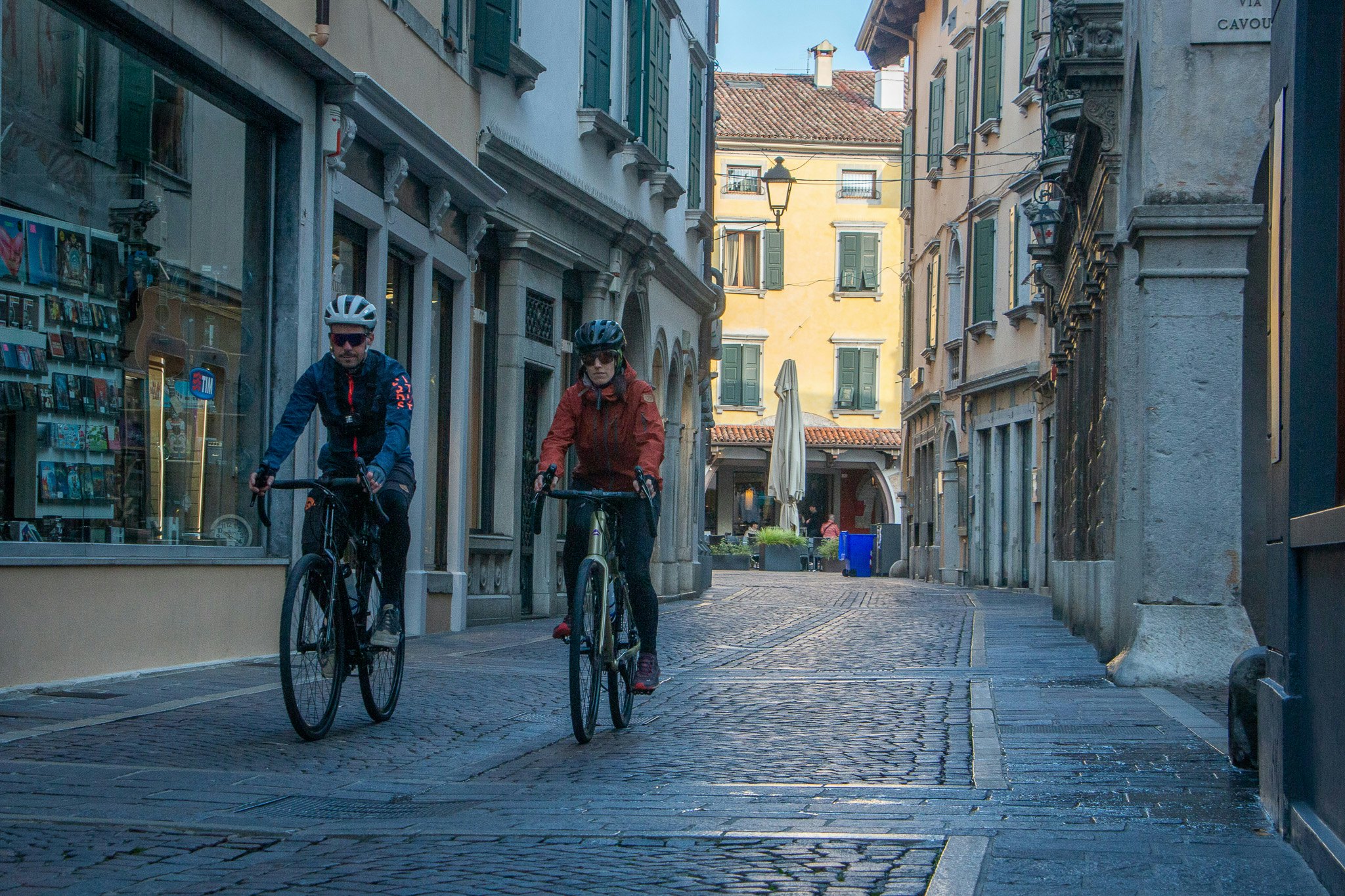
How to plan a bike trip on the new Alpina Mediterranean Cycle Route

Jul 1, 2025 • 7 min read

Here's how to plan a cycling trip on the new Alpina Mediterranean Cycle Route. Matevž Hribar
For months – or years – you might have been thinking about a cycling holiday in Europe. You know the advantages of seeing the continent by bike, the joy of moving at speed along rivers in the foothills of the mountains, as you undertake an adventure on a route like the six-stage 299km-long (186-mile) Alpina Mediterranean Cycle Route (AMCR). This new route launched in June 2025, and it starts in Italy, crosses into Slovenia, and finishes on the Adriatic Coast in Croatia.
End each day in another movie-set-beautiful village framed by mountains, where you’ll sip on a celebratory glass of sparkling wine or mug of beer as the church bell tolls across the main square and locals make their way between shops, bars and cafes.
Sound too idyllic? Well, the scene itself isn’t far-fetched, but the first thing keen cyclists should know, or accept, about cycle travel: it comes with a fair share of logistics, much of them surrounding the bicycle itself. As most experienced bikepackers and touring cyclists will tell you, the actual act of pedaling is the easy part. Before you get to that point, there is a list of tasks to complete and puzzles to solve.
The good news: solving logistical issues isn’t such a big deal if you know how to get started. In fact, dealing with – even enjoying – these tasks is part of what makes cycling so rewarding. You’ve gone that extra mile (pun intended) to step outside the conventional, conveyor-belt style of tourism. In doing so, you’re helping the environment, improving your health, and embracing community-based travel that holds the secrets to a country's culture. Not to mention that ice-cold beer tastes so much better after a day on the saddle.
Here's everything you need to know to plan a cycling trip on the new Alpina Mediterranean.

Where does the Alpina Mediterranean go?
The route begins in the eastern Italian region of Friuli-Venezia Giulia. The six-day itinerary leaves the village of Venzone (about 40km/25 miles north of Udine) and heads south along the Tagliamento River before veering east to the Slovenian border. Once in Slovenia, the trail tucks under the Julian Alps and follows the ethereally green Soča River for the better part of two stages. It then enters Slovenia’s pre-coastal Karst Region (east of Trieste) before making a nosedive to Opatija on Croatia’s coast.
Why choose the Alpina Mediterranean?
Finding the cycle route that suits your needs, skill level, culture preferences and desire to rough it (or not) are important decisions, both internally and with your cycle partners. That in mind, the “where” and “why” are closely connected as reasons for choosing your adventure.
The Alpina Mediterranean Cycle Route is a good all-around route with a combination of quiet roads and non-technical, unpaved sections. Any of the route's stages (or days) can be isolated as a single day's adventure or the route can be ridden as an overall itinerary, great for budding and experienced touring cyclists for several reasons. It is a solid itinerary for budding and experienced touring cyclists for several reasons. The route’s designers paid close attention to each stage’s (day’s) distance, elevation gain and points of interest (POIs) including accommodations, bike shops and restaurants. On average, one can expect to pedal around 50km (30 miles) per day with an average of about 600m (2000ft) of climbing. In addition, every stage is at least 75% paved, meaning the occasional “uneven” surface will spice things up, not wear you out.
Most importantly, the designers plotted the route through a culture-laden collection of regions that know how to welcome cyclists. Italy’s Friuli Region, Slovenia’s Soča Valley and Croatia’s Northern Adriatic Coast are loaded with diverse landscapes, ranging from snowy peaks to cobalt blue sea. And let’s not forget that this entire stretch is wine, cheese, prosciutto and olive oil country. For every calorie you burn, you’ll earn it back each night.

What season is best to ride?
Scheduling a cycling trip means making compromises. Many people might aim for the summer, but there are several reasons to avoid July and August and make arrangements for May to June or September to October.
First, most cyclists know heat is more detrimental to the body than any hill, and in the high season it never seems to end. Secondly, traffic increases during the summer months. Third, service providers are always more relaxed in the shoulder seasons of May to June and September to October. Finally, and most important for gourmand types, the food is better in the spring and fall when ingredients are either sprouting after a long winter or being harvested and bottled as the weather cools.
How do I navigate, and where do I eat and sleep?
A cycle route’s development is as much about sharing potential POIs as it is sharing a trail. For access to both detailed route coordinates and where to eat and sleep, cyclists should register for access to Alpina Mediterranean’s navigation pack, mapped via the Ride With GPS app. The itinerary, which can be viewed on your phone or other device, has turn-by-turn instructions across Italy, Slovenia and Croatia.
As you follow the app’s navigation, you’ll notice dozens of linked POIs pop up. These are recommended hotels, restaurants, and bike shops as well as parks, monuments and other attractions.

What type of bike should I ride?
Because the Alpina Mediterranean is, on average, more than 80% asphalt (quiet local roads), several bike types will work for your adventure: road bikes (with relatively skinny wheels of around 28mm); hard-tail mountain bikes (without rear suspension); and touring bikes (with upright geometry and “straight” handlebars) will suffice. The most versatile, fun, and sensible choice, however, are gravel bikes: hybrids with the geometry of a road bike, “drop” handlebars and mountain-bike sturdiness. The tire width is also a hybrid, ranging from 38mm to 45mm.
What should I pack?
The time of year will, partially, dictate your packing, but there are constants. One evergreen travel philosophy applies perfectly to cycling: take half the stuff and twice the money. In terms of gear, that means being realistic about what you actually need. Don’t worry about things being “dirty.” Your job is making sure you stay hygienic, not washing-machine fresh.
And remember: Everything you have needs to fit into the bike bag configuration you go with. I typically ride with a handlebar pack, a frame pack and a seat pack, which is affixed to the seat tube.
For a weeklong trip in early autumn on the AMCR, for example, bring:
Two cycling jerseys
Two pairs of cycling shorts
Three pairs of socks
A helmet
Cycling shoes
A windbreaker
Rain pants
A raincoat.
Post-ride, wine-sipping essentials include:
A pair of underwear
Light pants/skirt
A shirt
A bathing suit
Flip-flops
A jacket.
Non-clothing must-haves include:
Sunglasses
Sun lotion
Toiletries
Tire-changing tools
Your wallet, passport etc.
You’ll be tempted to take more post-ride clothes. Don’t. Minimalism is cool.

Should I go guided, self-guided or neither?
First, going “guided” means booking a tour to handle the details. This choice comes with an added expense, but also peace of mind and a local’s expertise about the AMCR’s landscape and culture. Self-guided – a step down in service, but a step up in independence – typically entails a purchased package that includes the GPS tracks and as many hotel bookings as you prefer. You can also ask about options like luggage transfer. For guided and self-guided options, Ljubljana-based operator Visit Good Place is a great choice. The “neither” option means you plan the excursion on your own: sort your bike and keep track of your route and places to eat and stay without any support.
Your level of cycling and travel experience will, to some degree, dictate the option you choose. For those riding the fence, keep in mind the AMCR is a straightforward and easily followed route surrounded by civilization – there are villages, towns, bike shops, restaurants and hotels en route.
Should I rent or bring my own bike?
Some people will fly with their rig anywhere for any length of time. A good general rule is to bring your own bike if the ride is more than two weeks. This equation is offset by whether there are options for quality rentals. In this case, there are multiple providers, including the aforementioned Visit Good Place.
How should I get to the Alpina Mediterranean Cycle Route?
There are three good options within striking distance of the Alpina Mediterranean Cycle Route, all with extensive train services and international airports: Venice and Trieste, in Italy, and Ljubljana, Slovenia.
Alex Crevar, a writer and cycle route developer, is a regular contributor to several international publications. His stories focus on the intersection of culture, adventure and community-based, human-powered travel.















